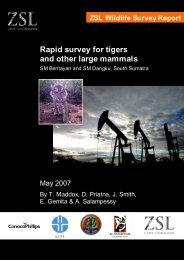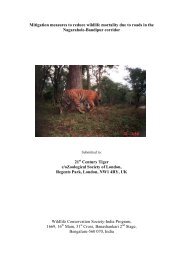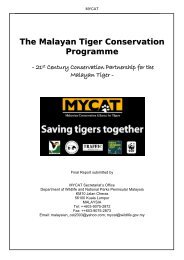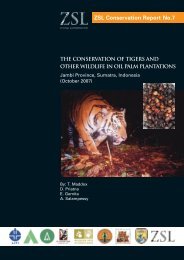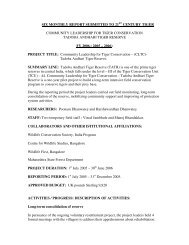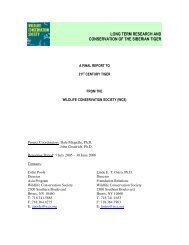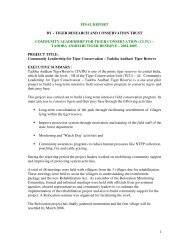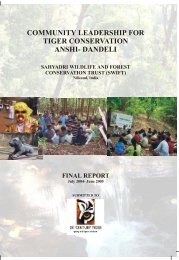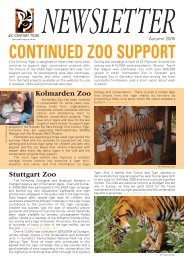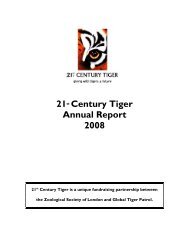CLTC Tadoba Andhari Final Report 2006 - 21st Century Tiger
CLTC Tadoba Andhari Final Report 2006 - 21st Century Tiger
CLTC Tadoba Andhari Final Report 2006 - 21st Century Tiger
Create successful ePaper yourself
Turn your PDF publications into a flip-book with our unique Google optimized e-Paper software.
FINAL REPORT<br />
BY – TIGER RESEARCH AND CONSERVATION TRUST<br />
PROJECT : COMMUNITY LEADERSHIP FOR TIGER CONSERVATION<br />
(<strong>CLTC</strong>) –TADOBA ANDHARI TIGER RESERVE – 2005-<strong>2006</strong>.<br />
EXECUTIVE SUMMARY:<br />
<strong>Tadoba</strong> <strong>Andhari</strong> <strong>Tiger</strong> Reserve (TATR) is one of the prime tiger reserves in central India,<br />
which falls under the level – III of the <strong>Tiger</strong> Conservation Unit (TCU) – 44. Community<br />
Leadership for <strong>Tiger</strong> Conservation – <strong>Tadoba</strong> <strong>Andhari</strong> <strong>Tiger</strong> Reserve is a pilot project to<br />
build a long-term intensive field conservation program to conserve tigers and their prey<br />
base.<br />
This project was carried out to build a long-term intensive field conservation program. Its<br />
main aim was to conserve tigers and their prey base through the following activities<br />
Long-term consolidation of the park through facilitating resettlement of villages<br />
lying within the tiger reserve.<br />
Improve protection system through motivation and training of the field staff of the<br />
state forest department.<br />
Monitoring and ‘Watch Dog’ activities and<br />
Community awareness programs to reduce human pressures like NTFP collection,<br />
poaching, fire and cattle grazing.<br />
RESEARCHERS: Poonam Dhanwatey and Harshawardhan Dhanwatey<br />
STAFF: Temporary field staff –<br />
Vinod Jambhule<br />
Manoj Bhandakkar.<br />
Mukesh Bhandakkar<br />
Devidas.<br />
COLLABORATORS AND OTHER ISTITUTIONAL AFFILIATIONS:<br />
Wildlife Conservation Society, India Program<br />
Centre for Wildlife Studies, Bangalore<br />
Wildlife First, Bangalore<br />
Maharashtra State Forest Department<br />
1
PROJECT DURATION: 1 st July 2005 – 30 th June <strong>2006</strong><br />
REPORTING PERIOD: 1 st July 2005 – 31 st December 2005.<br />
APPROVED BUDGET: UK pounds Sterling 9,820<br />
DESCRIPTION OF ACTIVITIES:<br />
Long Term consolidation of the Reserve -<br />
During the reporting period the project leaders and the field staff of TRACT worked on<br />
the relocation project 2 villages of the 6 villages lying within the <strong>Tiger</strong> Reserve.<br />
A total of 10 meetings were held with villagers from the 3 villages due for rehabilitation.<br />
These meetings were held to assist the villagers in ensuring that they receive the<br />
promised resettlement package as per the new Rehabilitation Act. As member of the<br />
Relocation Monitoring Committee, formal and informal meetings were held with officials<br />
from government agencies, elected representatives and community leaders to co-ordinate<br />
the implementation of the rehabilitation project and also to build community support for<br />
the project.<br />
In the biweekly visits of the field staff to the relocation site and the concerned officials,<br />
the following progress of the Relocation project has been recorded. TRACT has actively<br />
participated in all activities mentioned herein.<br />
Progress of relocation of 2 villages from <strong>Tadoba</strong> <strong>Andhari</strong> <strong>Tiger</strong> Reserve - Botezari<br />
& Kolsa<br />
A survey was conducted by the government with the help of NGO’s in January 2005 to<br />
measure the residential area of the villagers in the two villages.<br />
A letter of consent was signed on the 9 th Jan 2005 by each villager wherein he agreed to<br />
the package he would receive from the government. This consent is mandatory for the<br />
distribution and allotment of land to the villagers. The project leaders were present for<br />
this and signed as witness.<br />
January - On site – Uprooting and levelling done.<br />
Another survey was conducted in June 2005 to decide on the location of the residential,<br />
agricultural land and water bodies.<br />
June - On Site – Work held up due to rain. Fresh foliage seen all over the site.<br />
A meeting was held on the 2 nd September 2005 by the Collector, to review the progress<br />
of the work. All concerned officials from the revenue and forest department were present<br />
along with the project leaders.<br />
September - On site – Construction of lake complete. Residential plots demarcated and<br />
road decided on.<br />
October – On site – Internal roads getting laid. Levelling of agricultural land being done.<br />
2
November – On site – Residential plot details decided for the landless and landlords. Cost<br />
and details of house construction worked on. One model house constructed near the<br />
relocation site. Villagers and NGO’s were invited to approve of it.<br />
December – On site - Villagers objected to the Bamboo and cement roof and demand the<br />
house to have a roof with teak poles and baked mud tiles.<br />
January <strong>2006</strong> – The foundation for the new houses was laid by the Forest Minister of<br />
State. Plot numbers were given to the villagers. This was done in the presence of the<br />
officials of the revenue and forest department, the project leaders, staff of TRACT and all<br />
villagers concerned. Construction of the houses commenced on the same day.<br />
February – On site – Site visit by villagers on every Tuesday. TRACT staff have a<br />
meeting with all villagers on the site every Tuesday. Tender for the construction work<br />
given to a local construction company. Levelling of agricultural land and one village<br />
water body almost complete. Main electrical line laid.<br />
April – On site – Bricks for houses has been made of cement and ash. House brickwork<br />
close to completion. Tenders for tendu collection from site have been called for. This is<br />
being done to encourage villagers to occupy the new houses. Electric supply is available.<br />
May – Tribal Development Minister laid the foundation stone of the official buildings<br />
required in the village, as per the package promised.<br />
Plotting for agricultural land still undone.<br />
June – The villagers have still not moved out of the tiger reserve into this new site.<br />
Agricultural plots still not handed over to the villagers. Lake for agricultural fields is still<br />
incomplete. Construction work is disrupted due to heavy rains.<br />
Two houses were damaged by some miscreants to prove low quality of construction and<br />
to discourage villagers from occupying them. This was spayed in the media. But the<br />
damage has been undone.<br />
Improve protection -<br />
A number of formal and informal meetings were held with the senior officials regarding<br />
the discrepancies in the <strong>Tiger</strong> Reserve. The project leaders were invited by the Principal<br />
Chief Conservator of Forests (PCCF) to the <strong>Tiger</strong> reserve and a meeting held in the field<br />
wherein in the presence of all concerned Park officials, all observations about illegal<br />
activities detrimental to the Reserve, made by the project leaders and the field staff of<br />
TRACT during the <strong>CLTC</strong> project period were discussed and taken note of. The PCCF<br />
promised to take appropriate measures and directed the Field Director to take action at<br />
the earliest.<br />
Consolidation - A proposal for increasing the area of the <strong>Tiger</strong> reserve by consolidating<br />
on the peripheral forested tiger habitat into the <strong>Tiger</strong> reserve has been given to the Chief<br />
Minister and the Minister of State by the project leader (in his capacity as a member of<br />
the State Board for Wildlife) during the meeting of the State Board for Wildlife.<br />
3
For this proposal, data has been collected from the peripheral areas of the tiger reserve<br />
over a period of three months, using predetermined routes, on foot, and making<br />
observations of scat and sign encounters. The analysis for this proposal is close to<br />
completion. The report will be submitted to the Chief Minister in the next Board meeting.<br />
The inclusion of these peripheral areas, which has good tiger habitat, into the <strong>Tiger</strong><br />
Reserve will result in increased protection to these areas and a stop to the logging from<br />
here. This area could be home to the spill over population of tigers from the <strong>Tiger</strong><br />
Reserve and also ensure protection for the wildlife living and habitat here.<br />
GPS mapping - For the GPS mapping of the entire boundary of the <strong>Tiger</strong> Reserve, data<br />
collection was done for 3 months, in which the field staff of TRACT covered almost 40%<br />
of the area, after which, the Field director of <strong>Tadoba</strong> <strong>Andhari</strong> stated that this data was not<br />
required by the management. He withdrew permission of the field staff to move in and<br />
cross the <strong>Tiger</strong> Reserve on the bike for this data collection. This has led to incomplete<br />
data for this component.<br />
This complete map will assist the management get a clear picture of the encroachments<br />
done by the peripheral villagers into the <strong>Tiger</strong> Reserve.<br />
Monitoring and ‘watch dog’ activities -<br />
The field staff of TRACT is in the field on a daily basis, and their tracking skills have<br />
also been put to use by the authorities to patrol problem areas.<br />
Due to lack of permission for the field staff to move in the <strong>Tiger</strong> Reserve on foot, intense<br />
patrolling and monitoring has been done on a daily basis in the immediate adjoining<br />
peripheral forested areas of the <strong>Tiger</strong> Reserve. All irregularities observed in these areas<br />
have been recorded and the concerned forest officials have also been informed about<br />
these.<br />
As the permission to monitor the tiger reserve has been withdrawn by the field director,<br />
crucial information about the irregularities inside the Reserve could not be collected.<br />
But the staff of TRACT obtained information about a jaw trap found in a fire line in<br />
<strong>Tadoba</strong>. This was discovered when a forest guard’s foot got caught in the trap. Three<br />
more traps were found close to this area.<br />
Two tigers were found dead in February on the outskirts of TATR. One bear and two<br />
tigers were found dead inside the reserve in January, April and June <strong>2006</strong> respectively.<br />
Community Awareness -<br />
The project leaders attended 5 public functions where they spoke about the need for<br />
conservation.<br />
Project leader Poonam was invited to give a presentation on Eco Tourism and<br />
conservation in the district by a local body in the presence of the Minister of Forests and<br />
Minister of Tourism.<br />
4
Harshawardhan was invited by the Bombay Natural History Society to give a talk on the<br />
conservation work being done by TRACT in <strong>Tadoba</strong>. 8 Meetings were held with other<br />
local non – governmental organizations to build community support for the reserve.<br />
The project leaders organized ’RUN FOR WILDLIFE’, a 3.3 kilometres run in Nagpur<br />
for school children with an aim to create awareness amongst school children about the<br />
need to conserve forest and water. 723 children participated in the RUN from 40 schools.<br />
The Commissioner of Police flagged off the Run and the Principal Chief Conservator of<br />
Forests was the guest of honour.<br />
A ‘Slogan writing competition and a fancy dress competition were also held<br />
simultaneously with conservation of wildlife as the theme. The winners were awarded<br />
prizes by the Trust. This event attracted a lot of media coverage.<br />
ACKNOWLEDGEMENTS:<br />
The project team thank the donors, 21 st <strong>Century</strong> <strong>Tiger</strong>.<br />
The project team also thanks the Chief Wildlife Warden of Maharashtra, Reserve Warden<br />
and all the staff of the <strong>Tadoba</strong> <strong>Andhari</strong> <strong>Tiger</strong> Reserve.<br />
The project team wishes to thank Centre for Wildlife Studies for their guidance<br />
throughout the project and to Feral for their guidance and assistance in the GIS mapping<br />
done.<br />
The project team wishes to thank all the local NGO’s and individuals who assisted in the<br />
Marathon.<br />
GOALS / ACTIVITIES FOR NEXT YEAR -<br />
1. Continue conservation monitoring on the periphery of the <strong>Tiger</strong> Reserve.<br />
2. Pursue the voluntary rehabilitation project, do a relocation workshop and help<br />
maintain the decide time frame for the project.<br />
3. Continue the GPS mapping of the boundary of the <strong>Tiger</strong> Reserve.<br />
4. Conduct wildlife educational activities in the peripheral villages and those inside<br />
the reserves.<br />
5. Conduct field training camps for the staff of TATR.<br />
6. Organise intelligence network in more peripheral areas of TATR.<br />
7. Work towards getting peripheral areas under the <strong>Tiger</strong> reserve.<br />
5




